 Germany (1944), Coastal Subs, 16 planned, 7 completed
Germany (1944), Coastal Subs, 16 planned, 7 completedWW2 U-Boats:
Seeteufel (1944) | Type Ia U-Boats (1936) | Type II U-Boats (1935) | Type IX U-Boats (1936) | Type VII (generic) | VIIA | VIIB | VIIC | VIIC/41 | VIIC/42 | VIID | VIIF | Type XB U-Boats (1941) | Type XIV U-Boats (1941) | Type XVII U-Boats (1944) | Type XXI U-Boats (1944) | Type XXIII U-Boats (1944) | German mini-subs and human torpedoesThe Type-XVII U-Boat was the only attempt of the Kriegsmarine to run operational submarines with a very early type of “AIP” or “air independent propulsion”, a graal of underwater propulsion we now now and use, but which was sitll in its infancy in 1939. This was a gradual process, from theory to a frst prototype, V-80, and then an attempt at serial production with the Type-XVII in two series, with 16 planned total but only 7 completed in the firs phase of the project, coastal submerscibles to protect German home waters and operate in the north sea. More ambitious projects led to the Type XXI, but using streamline instead of the Walter turbine, which used a very dangerous compound. The technology was tried again in the 1950s and abandoned as nuclear power looked safer, leaving the Type XVII in a strange place, with a few boats built and never fully operational.
Development
In September 1939 the Kriegsmarine entered the war ill-prepared on all accounts. Its first plan Z fast battleships were in construction, it lacked cruisers and destroyers, and more so, surprisingly enough, only had few operational U-Boats, most of which being coastal models of the Type II and IIa. The Type VII was just introduced and most of its features were derived from the WWI UB-III design, hardly revolutionary. After the failure of the surface fleet in 1942 and ultimate replacement of Admiral Raeder by Dönitz in January 1943 with the fleet sent in Norway and U-Boat getting all industrial priority, it started tobe obvious that after the initial “happy times” from early 1941 to late 1942, the allies were rapidly catching up in ASW technology and numbers of escort.
In early 1943 the first escort carriers even entered service and constitution of independent hunter-killer groups started to slowly erode, then invert the kill/loss ratio of the battle of the Atlantic.
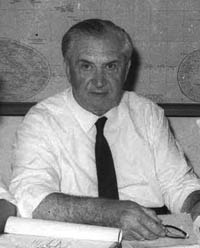 Already by mid-1942 there has been discussions about how to improve the survivability of diesel-electric submarine underwater, but the diesel-electric technology in place since WWI only saw minor improvements in speed and range. Speeds underwater remained poor and attacks were led in wolfpacks surfaced b night, only way to catchup convoys. With stronger hull, and soon adoption of the snorkel, radar detection and better AA, survibaility increased but the problem of performances underwater remained a crucial issue. That’s where the story of Prof. Helmuth Walter (1900-1980) comes in. He had undeed patented all the way back to 1925 a motor fuel system that uses nitrogen peroxide, a very unstable product but allowing a turbine to work with little or no vibration and a submarine to stay in underwater operation at high speed. This revolutionary process eventually interested the Nazis which commissioned a first project in 1933 but rearmament priorities still postponed it. The first prototype, V80 was operational only by 1939…
Already by mid-1942 there has been discussions about how to improve the survivability of diesel-electric submarine underwater, but the diesel-electric technology in place since WWI only saw minor improvements in speed and range. Speeds underwater remained poor and attacks were led in wolfpacks surfaced b night, only way to catchup convoys. With stronger hull, and soon adoption of the snorkel, radar detection and better AA, survibaility increased but the problem of performances underwater remained a crucial issue. That’s where the story of Prof. Helmuth Walter (1900-1980) comes in. He had undeed patented all the way back to 1925 a motor fuel system that uses nitrogen peroxide, a very unstable product but allowing a turbine to work with little or no vibration and a submarine to stay in underwater operation at high speed. This revolutionary process eventually interested the Nazis which commissioned a first project in 1933 but rearmament priorities still postponed it. The first prototype, V80 was operational only by 1939…
Trailblazer: V-80

The V-80 (German: Versuchs-U-Boot V 80) was a 76-ton, 22 meters long, experimental submarine, only “V” design for the Kriegsmarine in WW2. Completed in 1940 at Friedrich Krupp Germaniawerft in Kiel with well refined shapes, this four-man boat was designed around its revolutionaty Walter hydrogen peroxide-based turbine propulsion system. Trials showed it had a range of 50 nmi (93 km; 58 mi) at 28 knots (52 km/h; 32 mph) while submerged. This was the only attempt of a workable AIP since the Spanish Ictineo II. This was a midget submarine with no offensive capabilities, but it led to the design of the German Type XVII.
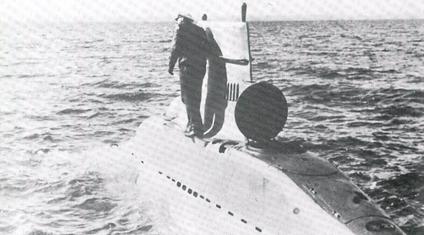
The “Walter Propulsion” submarine tested on the V80, setup an absolute record at the time only beaten with the 1960s SSNs of the cold war. The next step was to create a larger model with offensive capabilities (torpedo tubes) with V300 in 1942 featuring this time a new high-pressure turbine, albeit two years after the first V80 trials in 1940. The program was indeed still under low priority. Then came the first operational submarine in 1943, U-791, giving birth to the U-792 and 793, 794 and 795 all armed with forward torpedoes, going through month of gruelling semi-operational service.
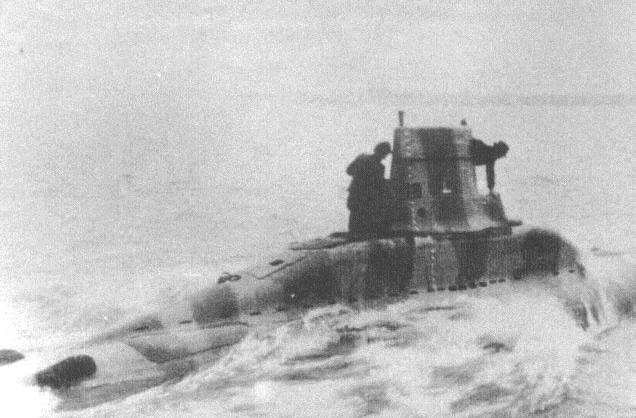
From Concept to Operation with the Walter Turbine
The fundamental problem behind Walter’s concept was the use of high-test peroxide (HTP). It was dangerous in 1939 and despiote the prowesses of V-80, capable of 28.1 knots (52.0 km/h; 32.3 mph) underwater, on 14 November 1941 Admirals Erich Raeder and Werner Fuchs, then at the head of the Kriegsmarine’s Construction Office after seeing a demonstration went to different conclusions. If Raeder was impressed, Fuchs was slow to approve further tests, worried about its sekeletal budget and other, more urgent priorities for the Kriegsmarine which at the time prioritized surface raiding above all else. Walter contacted Karl Dönitz in January 1942 to go above Fuchs’s lack of enthusiasm. He was well received. The future great admiral and head of state in 1945 embraced the idea and requested that these submarines went through an accelerated developement phase. An initial order was placed in the summer 1942 for four Type XVIIA, considered as an early step of development submarines.
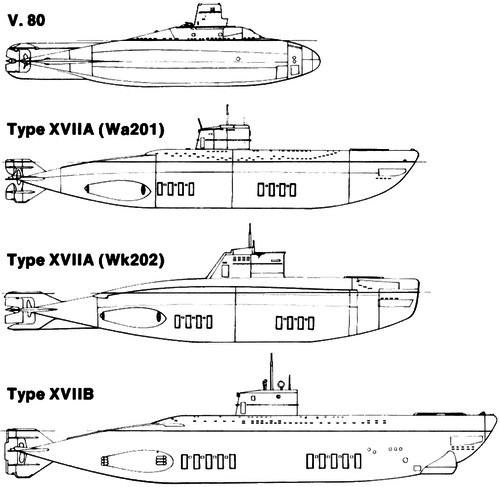
Various Types in this lineage: V80 (top), V-300, and Type XVIIA and B.
V-300 (1942)

Type WK202 in 1942, from pinterest
The 600-ton boat V-300, second prototype, was much larger than the V80, and beame the base for the Type XVII. She became, unlike V80, operational as U-791. She also managed 19 knots on trials. However construction, which started at Germaniawerft, was cancelled after Walter found the design too slow and proposed his own version, with smaller vessels rated for 220 tons. After a meeting with Dönitz in January 1942, new contracts base don this modified design were awarded for four at Germaniawerft, Kiel (Wk202 – U-792 and U-793) and Blohm & Voss, Hamburg (Wa201 – U-794 and U-795) to speed things up.
Keels were laid down in December 1942 for the first four, with U-792 being launched on 28 September 1943 and U-794 on 7 October. Their role was to be used as trainers for next crews. In trials they easily reached up to 25 knots submerged in 1944 and by March 1944, U-794 in full combat load while in the Bay of Danzig was measured by Dönitz and 4 other admirals, 24 knots. At the time it should be precised that the Flower class corvette for example reached barely 16 knots the best of times, the River class Frigate 20 knots in the same conditions, often below 16 knots in the heavy weather typical in the north Atlantic.
Construction
U-792 and U-793 were built under Wa 201 by Blohm + Voss. On trials, they achieved 20.25 kn (37.50 km/h; 23.30 mph) submerged. The other pair of XVIIA were U-794 and U-795, under project Wk 202, ordered to Friedrich Krupp Germaniawerft in Kiel for comparative tests. U-793 (wa 201) on trials achieved 22 knots (41 km/h; 25 mph) in March 1944, with Admiral Dönitz aboard. In June 1944, her sister U-792 achieved 25 knots (46 km/h; 29 mph) as planned, but only over a measured mile. A mile still, could be enough to flee a potential escort.
The Type XVIIA however were not liked by their crews. On trials, they were found hard to handle at high speed due to the small control surface and rear cross tail. Walter was not a naval designer. They were in addition riddled with issues resulting in a low efficiency. The greatest drawback, not overseen prior, was the lack of power, degraded due to the increase back pressure on the exhaust at depth. The design also showed a not favourable length to beam ratio causing high drag.
Admiral Fuchs, which already was not favourable to the class, concluded in his new report that he was against their deployment as they would take a lot of resources for dubious results, and hinder current production efforts. Dönitz however, which found the support of Hitler, had his way in the end. On 4 January 1943, twenty four Type XVII submarines were officially ordered.
Construction of the final Type XVII, now called the Type XVIIB, started at Blohm + Voss, Hamburg, and it was a new design with a simplified system, single shaft and turbine. The initial order in between was toned down from 16 to 12 planned numbered as U-1405 through U-1416. But Blohm + Voss at the time already had its hands full wit the Type XXI so it was eventually curtailed to just half, six.
Instead, twelve Type XVIIG, a new and slightly improved design were planned numbered U-1081 through U-1092 and ordered instead from Germaniawerft.
An evolution of th type was called the Type XVIIK, but it got rid of the Walter system for new, simpler closed-cycle Diesel engines fed with pure oxygen from onboard tanks. It was still highly inflamable, and there are doubts about what would happen in a depht-charge attack if one ruptured… Still, it was still seen as less dangerous thah HTP. Only U-798, was started and remained uncompleted at Krupp Germaniawerft in May 1945.
Of the whole programme, three Type XVIIB boats were completed at Blohm + Voss in 1943-1945, these were U-1405, U-1406 and U-1407,respectively on December 1944, February 1945, March 1945.
A further three numbered U-1408 to U-1410 were under construction in May 1945. Another six, U-1411 to U-1416 were cancelled before their keel was laid down, and Type XXIs were built instead with the same materials.
Design of the class

A model makers finished boat, showing an overview and idea of the colors of a Type XVIIB (pinterest).
Hull and general design
The Type XVII were different in design than any other U-Boats oin the Kriegsmarine’s inventory. Not only they were quite small, but the hull for the first time showed streamlining effort to reach the best performaces underwater, with a relative symmetry, especially at the aft end, shaped like torpedo. This was in contrast to traditional construction showing a clear upper hull with full deck from stem to stern. There, the flat section of the deck was embedded on a streamlined hull just as on the Type XXI. It ended abruptly aft of the conning tower.
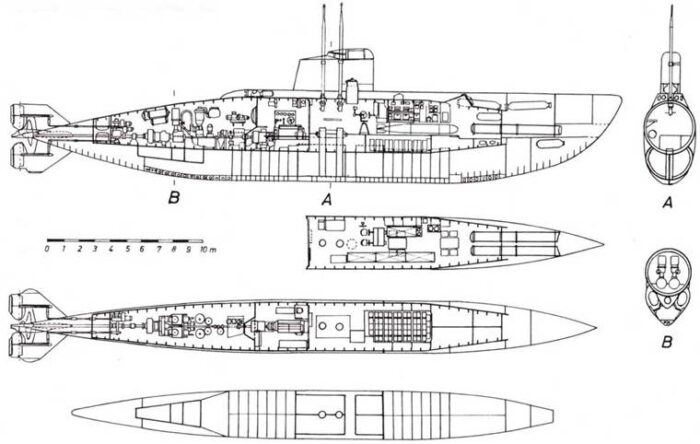
Wa 201 type (src pinterest and below).
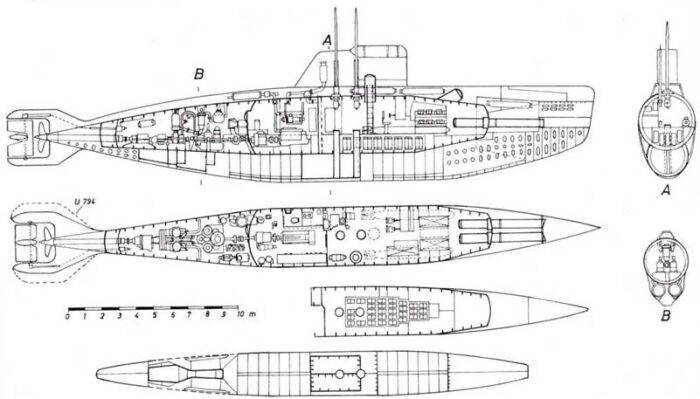
Wk 202 design, reconstructed (same)
The Type XVIIA diverged between them in size.
Wa 201: displaced 277 tonnes (273 long tons) surfaced, 309 t (304 long tons) submerged and 372 t (366 long tons) total. It was 39.05 m (128 ft 1 in) overall, for 26.15 m (85 ft 10 in), pressure hull alone, and 4.50 m (14 ft 9 in) in beam overall and 4.30 m (14 ft 1 in) in draught.
Wk 202: displaced less, 236 t (232 long tons) surfaced, 259 t (255 long tons) submerged and 312 t (307 long tons) total and measured 36.60 m (120 ft 1 in) overall and 3.40 m (11 ft 2 in) for the pressure hull, 4.55 m (14 ft 11 in) in draught.
The final Type XVIIB: Much larger at 312 t (307 long tons) surfaced, 337 t (332 long tons) submerged and 415 t (408 long tons) total.
It measured 41.45 m (136 ft 0 in) overall of which only 27.30 m (89 ft 7 in) of pressure hull and was 3.30 m (10 ft 10 in) wide for the pressure hull and 4.30 m (14 ft 1 in) in draught.
Powerplant
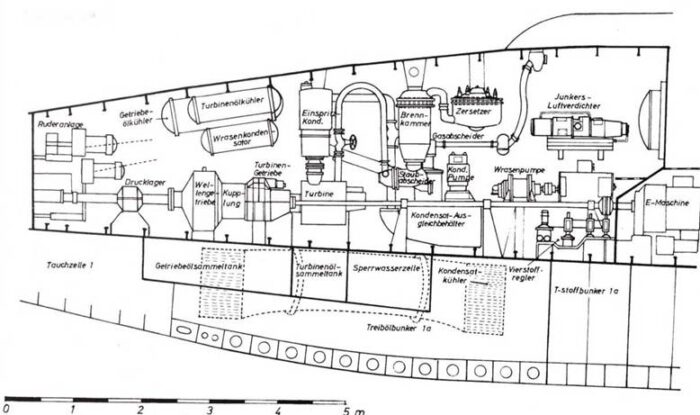
The hydrogen peroxide (H2O2) was used in a stabilized form called Perhydrol. Combustion of that fuel and oil produced the waited reaction, but it was a complex and dangerous process. The first installation comprised a single Deutz SAA SM517 supercharged 8-cylinder Diesel engine rated for 210 PS (210 shp; 150 kW) coupled to an AEG Maschine AWT98 electric motor, 77 PS (76 shp; 57 kW) on a single shaft.
The Type XVIIA Wa 201 U-792 and Wk 202 had two Walter gas turbines rated for a total of 5,000 PS (4,900 shp; 3,700 kW).
The Type XVIIA Wa 201 U-793 and the Type XVIIB however had a single Walter gas turbine rated for 2,500 PS (2,500 shp; 1,800 kW).
The Type XVIIA thanks to their initial powerplant managed 9 knots (17 km/h; 10 mph) surfaced, 5 knots (9.3 km/h; 5.8 mph) submerged on electric drive and 25 knots (46 km/h; 29 mph) submerged on HTP drive.
The Type XVIIB and their single turbine managed still 8.8 knots (16.3 km/h; 10.1 mph) surfaced, the same 5 knots (9.3 km/h; 5.8 mph) submerged on electric drive and still 25 knots (46 km/h; 29 mph) submerged on HTP drive.
As for range the Type XVIIA, Wa 201 was capable of 2,910 nmi (5,390 km; 3,350 mi) at 8.5 knots (15.7 km/h; 9.8 mph) surfaced, 50 nmi (93 km; 58 mi) at 2 knots (3.7 km/h; 2.3 mph) submerged on electric drive and 127 nmi (235 km; 146 mi) at 20 knots (37 km/h; 23 mph) submerged on HTP drive.
Wk 202 was capable of 1,840 nmi (3,410 km; 2,120 mi) at 9 knots (17 km/h; 10 mph) surfaced, 76 nmi (141 km; 87 mi) at 2 knots (3.7 km/h; 2.3 mph) submerged on electric drive and a less stellar 117 nmi (217 km; 135 mi) at 20 knots (37 km/h; 23 mph) submerged on HTP drive.
The Type XVIIB however were capable of a more workable range of 3,000 nmi (5,600 km; 3,500 mi) at 8 knots (15 km/h; 9.2 mph) surfaced, 76 nmi (141 km; 87 mi) at 2 knots (3.7 km/h; 2.3 mph) submerged on electric drive and a more remarkable 123 nmi (228 km; 142 mi) at 25 knots (46 km/h; 29 mph) submerged on HTP drive.

Armament
The Armament was a bit of an afthought, with just two bow tubes, standard type and reload as there was no room for a complicated autloader. These tubes fired a stangard G7e type 53.3 cm (21 in) torpedo, already preloaded in the tubes, with two reserve torpedoes stored on the torpedo room floor. The crew comprised 12 officers and men for the Type XVIIA and 19 for the Type XVIIB.
⚙ XVIIA specifications |
|
| Displacement Wa 201: | 277t surfaced, 309t submerged, 372t |
| Displacement Wk 202: | 236t surfaced, 259t submerged, 312t total |
| Dimensions Wa 201: | 39.05/26.15 x 36.60 x 41.45/27.30m x 4.50 m (128 ft 1 in x 120 ft x 14 ft 9 in) |
| Dimensions Wk 202: | Same but 3.40 m (11 ft 2 in) pressure hull |
| Propulsion | Deutz SAA SM517 8-cyl. Diesel 210 PS, AEG Maschine AWT98 EM 77 PS |
| Propulsion Wa 201/wk 202 | 2 × Walter gas turbines*, 5,000 PS (4,900 shp; 3,700 kW) |
| Speed | 9 kts surfaced, 5 kts submerged, 25 kts submerged HTP drive |
| Range Wa 201 | 2,910 nmi/8.5 knots surfaced, 50 nmi/2 kts sub or 127 nmi/20 kts sub HTP |
| Range Wk 202 | 1,840 nmi/9 kts surfaced, 76 nmi/2 kts, sub, 117 nmi/20 kts sub HTP |
| Armament | 2× 53.3 cm (21 in) TTs bow, 2× reserve |
| Crew | 12 |
⚙ XVIIB specifications |
|
| Displacement | 312t surfaced/337t submerged, 415t total |
| Dimensions | Same but 3.30 m (10 ft 10 in) x 4.30 m (14 ft 1 in) draft |
| Propulsion | 1 × Walter gas turbine, 2,500 PS (2,500 shp; 1,800 kW) |
| Speed | 8.8 kts surfaced, 5 kts submerged, 25 kts submerged HTP |
| Range | 3,000 nmi/8 kts surfaced, 76 nmi/2 kts sub, 123 nmi/25 kts sub |
| Crew | 19 |
Forging German Cold War subs
All three completed Type XVIIB boats were scuttled by their crews (se later) in May 1945, U-1405 at Flensburg, U-1406 and U-1407 at Cuxhaven in the British Zone of Occupation on 7 May 1945 by Oberleutnant zur See Gerhard Grumpelt. Kapitän zur See Kurt Thoma prohibited scuttling, and sentenced Grumpelt to seven years imprisonment by a British military court. At the Potsdam Conference in July 1945, these small boats were conveted war prizes indeed: U-1406 was allocated to the United States, U-1407 to Britain, both salvaged with the utmost priority. The goaal was to prevent the Soviets having their hands on these. The uncompleted U-1408 and U-1410 were captured at Blohm + Voss by the British Forces and scrupulously studied and scrapped on site.
The USN did not repair U-1406, already busy with two workable Type XXI submarines. It was carried to the US on a deck cargo, stripped after fire damage and flooding. Portsmouth Naval Shipyard team inspected it and estimated a budget of $1 million to have her repairs and workable. This of course was rejected, especially as early British reports on the HTP stressed the high fire hazard and high cost. U-1406 was studied and once the plans were in bow, she was scrapped at New York from 18 May 1948.

The Royal Navy on its side went the extra mile to full repair U-1407. She was recommissioned on 25 September 1945 as HMS Meteorite and was used for the short-lived the Explorer-class submarines.
Career of the XVIIA
 U-792
U-792
Wa 201 type — Blohm + Voss, Hamburg. U-792 was operational but only used as a trials vessel and did noit undertake any combat patrols. Instead she was assigned for a serie of tests helping fitting out the remainder of the series. She was first in the 5th U-boat Flotilla, then the 8th U-boat Flotilla, and back to the 5th flotilla. In December 1944, her new captain was Oberleutnant zur See Hans Diederich Duis. In March 1945 she became a floating fuel bunker. She was eventually scuttled on 4 May 1945 in the Audorfer See, Kaiser Wilhelm Canal, near Rendsburg as part of Operation Regenbogen. Her wreck was located on 26 May 1945, and then lifted by the British, taken to the Howaldtswerke in Kiel to be thoroughly examined and became a prize used extensively for trials until scrapped. She was however not as tested and fuly repaired as U-1407 nor commissioned given her general state.
 U-793
U-793
The second Wa 201 type also from Blohm + Voss was U-793. She, too, was operational, but only worked as a trials vessel. She never sailed out in patrols and like her sister aletrnated between the 8th U-boat and 5th U-boat Flotilla. She was scuttled on 4 May 1945 in the Audorfer See Kaiser Wilhelm Canal (Operation Regenbogen). Note: This operation was a planned mass scuttling of the German U-boat fleet, to avoid surrender. It was approved by Dönitz as a matter of honor as in WWI. These operationbs started on 1st May (Warnemünde), 2 May (Travemünde), 3 May (Kiel and Hamburg), 4 May (Kiel canal, Flensburg), 5 May (Baltic, Gelting Bay, Flensburg and other points, North Sea coast, Wilhelmshaven, Weser estuary.), 6 May (Cuxhaven and other points). On 8 May, 52 surrendered, two fled to Portugal, two arrived in Argentina, dawing a lot fo speculations.
The wreck of U-793 was rediscovered on 26 May 1945, lifted by the British, taken to the Howaldtswerke, Kiel for examination, as a prize, used for trials, stripped and scrapped.
 U-794
U-794
First of the Wk 202 pair from Germaniawerft, Kiel, U-794 like her ealier sisters was there only as a trials vessel. For a time, engieneers from Friedrich Krupp assistes these trials and brough setup recommendations and fixes. Her keel has been laid down on 1 February 1943, she was launched on 7 October, commissioned on 14 November with a Feldpost Number “M 52 496”. She saw no combat patrols and instead stayed with the 5th U-boat Flotilla, 8th U-boat Flotilla and 5th flotilla again. By late March 1944, Admiral Karl Dönitz and four other admirals were present for a trial of U-794 and were enthusiastic as she performed well above 24 knots, but was found difficult to manoeuvre. Her keel to beam ratio notably was too high ans sge was found sluggish undeerwater, mediocre surfaced. Like her sisters she was scuttle during Operation Regenbogen on May 5 1945 in Gelting Bay, later raised by the british, studied and broken up.
 U-795
U-795
The second Wk 202 from Germaniawerft, Kiel, U-795, was laid down on 2 February 1943 in Kiel and launched on 21 March 1944, commissioned on 22 April 1944 under the command of Oberleutnant zur See Horst Selle. She was a trials boat at the 8th U-boat Flotilla until 15 February, then 5th U-boat Flotilla until 3 May 1945.
On 3 May she was in refit when Operation Regenbogen was ordered. While in dry dock at Kiel, her engine room was destroyed with explosives to prevent her capture. She was found later in that state and BU.
Fate of the XVIIB
 U-1405
U-1405
U-1405 was the first production boat from Blohm and Voss, Hamburg at Yard number 255 on 15 October 1943, launched on 1 December 1944 and commissioned on 21 December 1944. U-1405 did not took part in any war patrols and was assigned as a training boat with the 8th U-boat Flotilla under Ltnt. Wilhelm Rex, then the 5th U-boat Flotilla to prepare future crews to more boats of that class. U-1405 was scuttled on 5 May 1945 in Eckernförde Bay during Operation Regenbogen. Her wreck was later raised and broken up.
 U-1406
U-1406

U-1406 was the second “production boat”, laid down at Blohm + Voss, Hamburg, on 30 October 1943 at yard number 256. She was launched on 2 January 1945 and commissioned under command of Oberleutnant zur See Werner Klug on 8 February 1945. Like her sister she saw no war patrols, assigned instead to trials and training to the 8th U-boat Flotilla, then 5th U-boat Flotilla. She was surrendered on 5 May 1945 at Cuxhaven, but scuttled on 7 May as part of Operation Regenbogen. She was not in the US sector, but was attributed to the US by the Postdam commission, so she was raised, transported to the U.S., studied and broken up after 18 May 1948.
 U-1407
U-1407
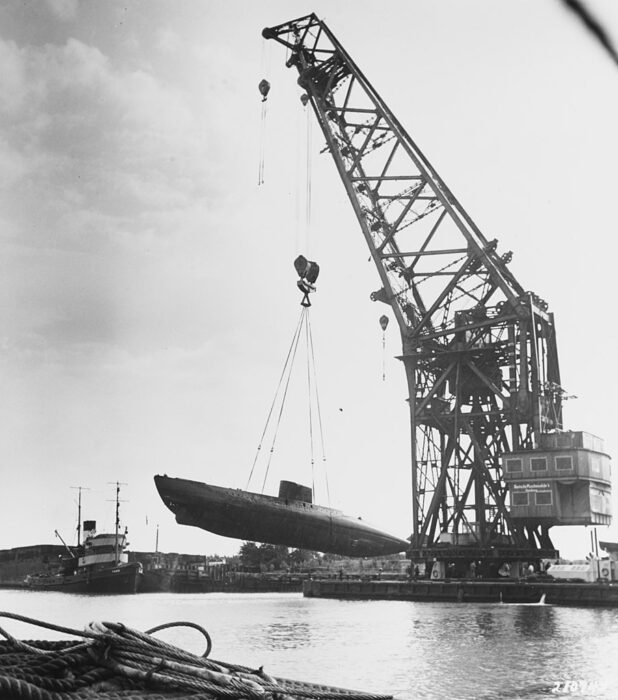
U-1407 raised postwar.
U-1407 was laid down at Blohm + Voss, Hamburg at yard number 257 on 13 November 1943, launched on February 1945, commissioned on 13 March 1945. Like her sisters she was used for training and never went out at sea for patrol operations. That late in the war she would have been caught by the imposing ASW barrier of patrol ships and aircraft in the Skagerrak and north sea. On 7 May at Cuxhaven, in the British Zone of Occupation she was scuttled by Oberleutnant zur See Gerhard Grumpelt despite contrary orders by Kapitän zur See Kurt Thoma, which was against operation Regenbogen and prohibited such actions. Grumpelt was sentenced to seven years’ imprisonment by a British military court later. At the Potsdam Conference in July 1945, U-1406 was allocated to the US, U-1407 to the United Kingdom and salvaged. She was repaired and commissioned as “HMS Meteorite” for trials until September 1949, scrapped afterwards. Her service led to the mediocre coldwar Explorer class submarines which proved once and for all that HIP (T-stoff) was a dangerous concept and nuclear power preferrable.
 U-1408 – 1410
U-1408 – 1410
These series from U-1408 to U-1410 were laid down at Blohm + Voss, Hamburg, but incomplete when the war ended. They were scrapped on site.
 U-1411 – 1416
U-1411 – 1416
Same, at Blohm + Voss in Hamburg, U-1411, 1412, 1413, 1414, 1415, 1416 had their contract cancelled before even construction began.
Succession and Projects
In 1942 Walter proposed a 1,475 ton Type XVIII capable of carrying 23 torpedoes (and supposedly given the same autoloader as on the Type XXI). Two contracts were awarded on January 4, 1943, to Deutsche Werke in Kiel. They were numbered U-796 and U-797, until cancelled on 28 March 1944 for the more realistic XXI, a spin-off of the design but replacing the advantages of an AIP by the cople streamlining/huge battery power. This alowed them to reach 17 knots underwater, not that far away, and with far less hazards.
Read More/Src
Books
Grier, Howard D (2007). Hitler, Dönitz, and the Baltic Sea. Naval Institute Press. p. 174.
Akermann, Paul (2002). Encyclopedia of British Submarines 1901–1955. Periscope Publishing. p. 471.
Polmar, p. 35 Madsen, Chris (1998). The Royal Navy and German Naval Disarmament, 1942-1947. Routledge.
Friedman, Norman (1994). U.S. Submarines Since 1945: An Illustrated Design History. Naval Institute Press.
Gröner, Erich; Jung, Dieter; Maass, Martin (1991). German Warships 1815–1945, U-boats and Mine Warfare Vessels. Vol. 2. Conway Maritime Press.
Polmar, Norman; Kenneth J. Moore (2004). Cold War Submarines: The Design and Construction of U.S. and Soviet Submarines. Brassey’s.
Rössler, Eberhard (2001). The U-boat: The evolution and technical history of German submarines. London: Cassell & Co.
Williamson, Gordon (2005). Wolf pack: The story of the U-boat in World War II. Oxford: Osprey Publishing.
Sharpe, Peter (1998). U-Boat Fact File: Detailed Service Histories of the Submarines Operated by the Kriegsmarine 1935-1945. Leicester: Midland Publishing
Links
on coollib.com/ (RU)
ie.pinterest.com/ type-xvii schematics
on uboat.net/ walter history
uboat.net/types/xviia.htm
uboat.net/types/xviib.htm
uboat.net/boats/u1405.htm
ubootarchiv.de/ XVII_B
u-boote.fr/ walter_xxvi.htm
uboat.net/ walter_hist.htm
uboat.net/types/v80.htm
web.archive.org/ sharkhunters.com/
coollib.net/b RU article
en.wikipedia.org Type_XVII_submarine
en.wikipedia.org submarine_V-80
navalunderseamuseum.org book TW undersea-war/
ww2-weapons.com walter-u-boat/
Type XXVI plans

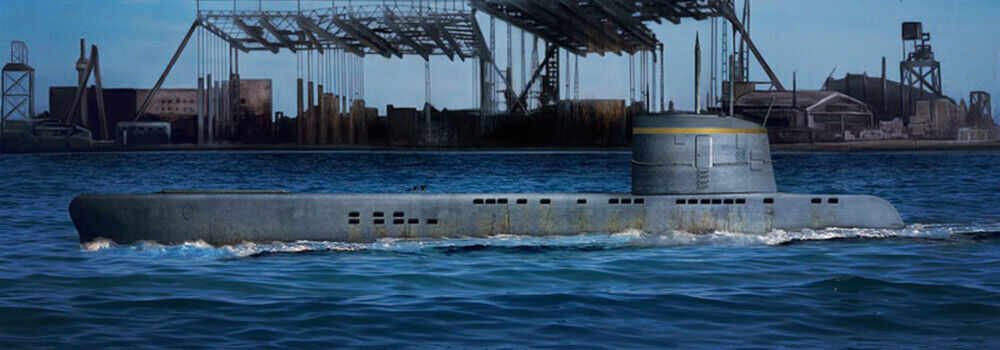
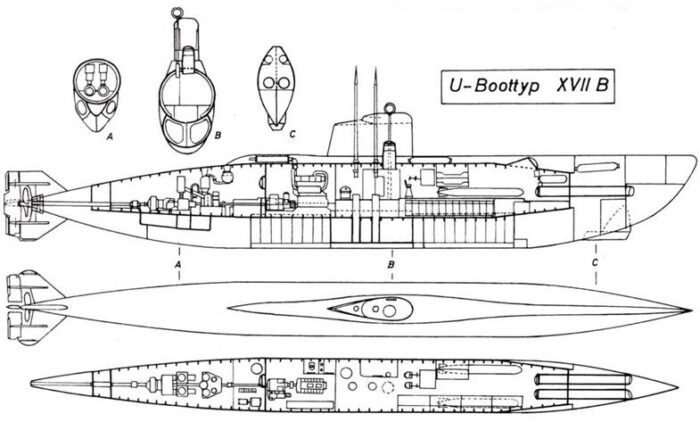
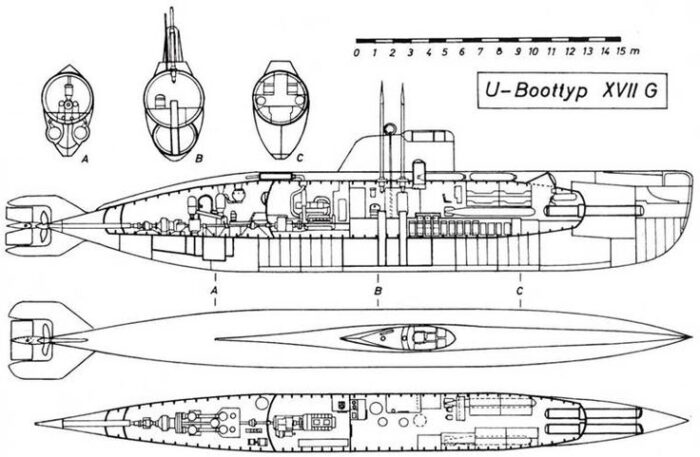
 Latest Facebook Entry -
Latest Facebook Entry -  X(Tweeter) Naval Encyclopedia's deck archive
X(Tweeter) Naval Encyclopedia's deck archive Instagram (@navalencyc)
Instagram (@navalencyc)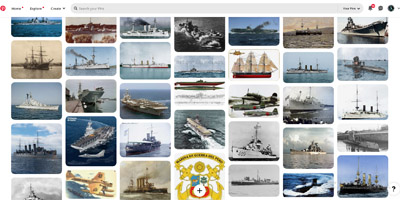

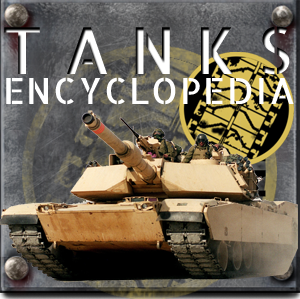
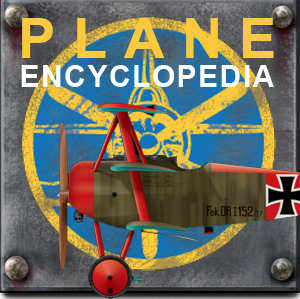
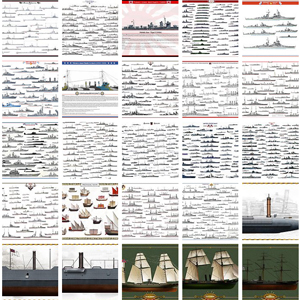
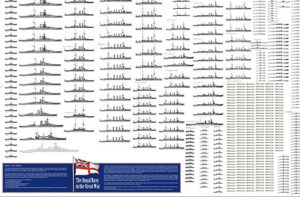
 French Navy
French Navy Royal Navy
Royal Navy Russian Navy
Russian Navy Armada Espanola
Armada Espanola Austrian Navy
Austrian Navy K.u.K. Kriegsmarine
K.u.K. Kriegsmarine Dansk Marine
Dansk Marine Nautiko Hellenon
Nautiko Hellenon Koninklije Marine 1870
Koninklije Marine 1870 Marinha do Brasil
Marinha do Brasil Osmanlı Donanması
Osmanlı Donanması Marina Do Peru
Marina Do Peru Marinha do Portugal
Marinha do Portugal Regia Marina 1870
Regia Marina 1870 Nihhon Kaigun 1870
Nihhon Kaigun 1870 Preußische Marine 1870
Preußische Marine 1870 Russkiy Flot 1870
Russkiy Flot 1870 Svenska marinen
Svenska marinen Søværnet
Søværnet Union Navy
Union Navy Confederate Navy
Confederate Navy Armada de Argentina
Armada de Argentina Imperial Chinese Navy
Imperial Chinese Navy Marinha do Portugal
Marinha do Portugal Mexico
Mexico Kaiserliche Marine
Kaiserliche Marine 1898 US Navy
1898 US Navy Sovietskiy Flot
Sovietskiy Flot Royal Canadian Navy
Royal Canadian Navy Royal Australian Navy
Royal Australian Navy RNZN Fleet
RNZN Fleet Chinese Navy 1937
Chinese Navy 1937 Kriegsmarine
Kriegsmarine Chilean Navy
Chilean Navy Danish Navy
Danish Navy Finnish Navy
Finnish Navy Hellenic Navy
Hellenic Navy Polish Navy
Polish Navy Romanian Navy
Romanian Navy Turkish Navy
Turkish Navy Royal Yugoslav Navy
Royal Yugoslav Navy Royal Thai Navy
Royal Thai Navy Minor Navies
Minor Navies Albania
Albania Austria
Austria Belgium
Belgium Columbia
Columbia Costa Rica
Costa Rica Cuba
Cuba Czechoslovakia
Czechoslovakia Dominican Republic
Dominican Republic Haiti
Haiti Hungary
Hungary Honduras
Honduras Estonia
Estonia Iceland
Iceland Eire
Eire Equador
Equador Iran
Iran Iraq
Iraq Latvia
Latvia Liberia
Liberia Lithuania
Lithuania Mandchukuo
Mandchukuo Morocco
Morocco Nicaragua
Nicaragua Persia
Persia San Salvador
San Salvador Sarawak
Sarawak Uruguay
Uruguay Venezuela
Venezuela Zanzibar
Zanzibar Warsaw Pact Navies
Warsaw Pact Navies Bulgaria
Bulgaria Hungary
Hungary

 Bundesmarine
Bundesmarine Dutch Navy
Dutch Navy Hellenic Navy
Hellenic Navy Marina Militare
Marina Militare Yugoslav Navy
Yugoslav Navy Chinese Navy
Chinese Navy Indian Navy
Indian Navy Indonesian Navy
Indonesian Navy JMSDF
JMSDF North Korean Navy
North Korean Navy Pakistani Navy
Pakistani Navy Philippines Navy
Philippines Navy ROKN
ROKN Rep. of Singapore Navy
Rep. of Singapore Navy Taiwanese Navy
Taiwanese Navy IDF Navy
IDF Navy Saudi Navy
Saudi Navy Royal New Zealand Navy
Royal New Zealand Navy Egyptian Navy
Egyptian Navy South African Navy
South African Navy






























 Ukrainian Navy
Ukrainian Navy dbodesign
dbodesign